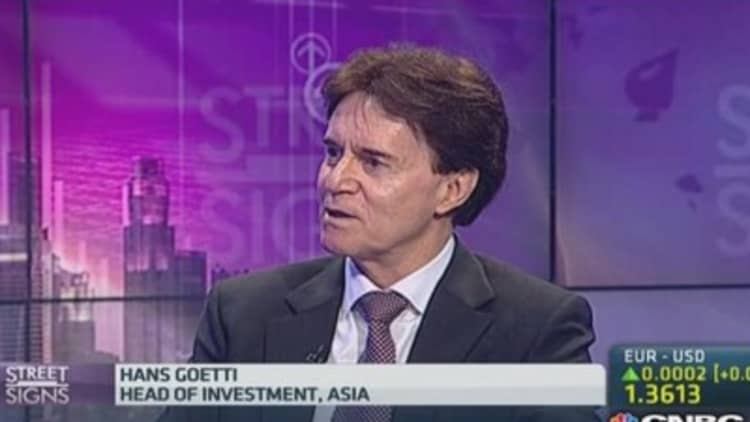Bonds have long been viewed as a port in the storm, a low-risk asset class that creates consistent cash flow and helps to balance equity market mood swings.
But with rates for Treasuries and other safe haven securities barely keeping pace with inflation—and in some cases falling behind—yield-hungry investors have been forced to purchase fixed-income products with a bigger potential payout. That puts their portfolios at greater risk.
"I don't think they have a clue about the risks involved," said Dan Veru, chief investment officer of Palisade Capital Management. "Average investors are simply out there buying yield, and they don't care whether they're getting it from owning lower-grade fixed-income products, dividend stocks or master limited partnerships."
Indeed, bonds are an investment like any other. Even government-backed securities are sensitive to interest-rate moves and inflation, which impact their performance and your return.
At the same time, callable bonds, in which the issuer reserves the right to repay their debt before maturity, can expose investors to reinvestment risk. And anyone who held high-yield bonds, or junk bonds, when the financial markets tanked in 2001 and 2008 knows full well they can be tough to unload.
Here's a look at the top six ways the most benign securities in your asset mix can potentially pack a punch.
1. Interest-rate risk
Bond prices and interest rates have an inverse relationship. When one goes up, the other goes down.
Many economists expect to see interest rates start to rise by the end of this year. Should that occur, the coupon rate (or interest payments) for the bonds you already own will be less attractive to investors. To sell them, then, you would have to offer those bonds at a lower price, or discount, enabling buyers to generate the same relative return that they would get if they were to purchase a new bond issue at the higher rate.
In short, your bond is worth less.
"We know the direction of yields is going to be higher," said Veru. "It's interesting that investors are worried about complacency in the equity market, but I believe there's far more complacency in the bond market."
With the flurry of new product offerings—including "exotic ETFs," which allow you to make leveraged bets on the direction of Treasuries—it's unclear what impact rising rates may have. "These things haven't been tested in times of stress," said Veru. "We don't know what happens when the earth moves."
To determine how sensitive your bond or bond fund is to interest-rate hikes, you must understand duration.
Duration is a complex equation expressed as a number that indicates how much the price of your bond investment will likely fluctuate when interest rates change. The higher a bond's duration, the more rate sensitive it is.
A bond fund with a 10-year duration, for example, will decrease in value by 10 percent if interest rates rise 1 percent (or 20 percent if rates rise 2 percent). Conversely, it will increase by 10 percent if rates fall by 1 percent.
Read MoreInvestors don't know what to do about rising rates
The Financial Industry Regulatory Authority warns that outstanding bonds, particularly those with a low interest rate and high duration, may experience significant price drops as interest rates rise.
Zero-coupon investments, which make all their interest payments when the bond matures, are among the most vulnerable to interest-rate swings.
Investors are worried about complacency in the equity market, but I believe there's far more complacency in the bond market.Dan Veruchief investment officer of Palisade Capital Management
2. Bond fund risk
Unbeknownst to many, bond funds also expose investors to a unique set of risks in a rising rate environment that individual bonds do not. Why?
Individual bonds, like Treasuries, municipals and corporate bonds, are sold with a finite maturity: the date on which you, the investor, get your principal back—if the debt issuer doesn't default—and the interest payments you've been receiving stop.
Interest-rate fluctuations don't affect investors who hold individual bonds to maturity.
Fixed-income securities held within a bond fund, however, are designed to mature on a staggered basis, creating a perpetual income stream for investors. The fund manager replaces bonds as they mature, when the issuer's credit is downgraded and when the issuer "calls," or pays off the bond before the maturity date.
Read MoreBonds vs. bond funds: What you need to know now
When bond prices fall as interest rates rise, the net asset value (NAV) and return of a bond fund also decline, said Greg Ghodsi, senior vice president of investments at Raymond James.
A $300,000 investment in a fixed-income mutual fund with an average maturity of 20 years (a mix of 10-, 20- and 30-year bonds), for example, would be worth $260,000 if interest rates climb just 1 percent. (Shorter-term bond funds would be less volatile.)
But the pain doesn't end there. The drop in value makes investors nervous, which prompts more selling. That forces the fund manager to unload some of their holdings to meet redemptions, said Ghodsi.
Depending on how significant the redemptions are, he noted, they may have to sell their highest-yielding bonds and replace them with those offering a lower yield, or assume more risk to obtain the same return, which can drive prices quickly lower.
The investors who didn't bail get stuck with an investment that may not match their risk profile or income needs—one that is suddenly a lot less liquid on the secondary market. Ouch.

3. Credit risk
The yield for bond investments correlates closely to the creditworthiness of the corporate or government issuer. The major credit-rating agencies—Moody's, and Fitch Ratings—review their financial stability and grade them based on their projected ability to repay debt obligations.
Investors are compensated for the assumption of risk.
Treasuries, for example, are considered the safest investment because they are backed by the federal government. As such, the benchmark 10-year Treasury currently yields roughly 2.6 percent—only marginally higher than the 2.1 percent rate of inflation. The five-year Treasury is yielding 1.7 percent, and the three-year bond is below 1 percent.
Slightly higher on the risk continuum, many investment-grade corporate bonds are currently yielding about 3 percent.
The riskiest issues, including high-yield corporate bonds, emerging markets debt, floating-rate bonds and low-grade municipals, pay the most. High-yield corporate bonds often pay out 5 percent or more, but be forewarned: If the issuer defaults, you could lose it all—including your principal.
A bond issuer defaults when they are unable to make interest or principal payments to a debt holder. When corporations file for bankruptcy, secured bondholders may see a portion of their original investment (principal) returned, but rarely do they get all of it.
Read MoreThe yield curve: CNBC Explains
"Funds with more credit risk are bond funds in name, but they are not necessarily going to give you diversification from equity risk in your portfolio," said Sarah Bush, a fixed-income analyst with Morningstar.
Keep in mind, too, that it doesn't take a bankruptcy to deliver a blow.
More commonly, bond prices fall after a downgrade to the issuer's credit rating, which happens when the agencies determine that its financial position has deteriorated. Price declines also occur when the agencies place bond issuers on "credit watch" status. Credit downgrades can affect bonds of any credit quality," said Bush.
4. Liquidity risk
That 5 percent yield on the junk bond you just bought may look good now, but consider what could happen when the next market downturn takes hold.
Though larger in total value, the bond market is far less liquid than the stock market. There are simply fewer investors and traders.
While government bonds can usually be sold quickly at an efficient price, corporate bonds—especially junk bonds—can be tough to unload during flights to quality. You may be forced to sell at a lower price or be unable to sell it at all.
"Instead of holding up during the last financial crisis, it was the highest-quality stocks and bonds that got sold first, because investors could sell them," said Veru.
A good rule of thumb: The smaller the issuer, the larger the liquidity risk.
5. Inflation risk
At the moment, inflation is mild, but if history is any guide, it won't remain so forever. As a general rule, when consumer prices climb, purchasing power declines. So, too, does the "real value" of your fixed-income investment, which is calculated after inflation.
If you buy a five-year bond at 5 percent, for example, but the rate of inflation is 7 percent, the "real yield" on your investment is negative 2 percent. In effect, you've lost money.
Treasury Inflation Protected Securities (TIPS), short-term bonds, and commodities such as gold are frequently used as a hedge against inflation. But Bush warns that TIPS, in particular, "can also be very interest-rate sensitive."
6. Reinvestment risk
When the economy slows down and interest rates decline, bond investors face a different snag.
As their bonds mature, they are forced to reinvest their interest earned and any return of principal in securities with a lower rate of return. That reduces the income being generated by their bond portfolio.
The same threat exists with callable bonds. If rates fall, corporate issuers may opt to repay their outstanding debt obligations and reissue their bond at a lower rate.
Reinvestment risk is greater for bonds with higher coupon or interest payments. Zero-coupon bonds, however, have no reinvestment risk.
"Because you don't collect interim coupon payments, your final return is not at all dependent on your ability to reinvest coupon payments," said Bush.
Bonds and bond funds play an important role in a balanced portfolio. But they aren't devoid of risk.
Individual investors need to know what they own and consider their own risk profile before blindly chasing yield.
"You have to consider what role bonds play in your overall portfolio," said Bush.
—By Shelly Schwartz, special to CNBC.com



